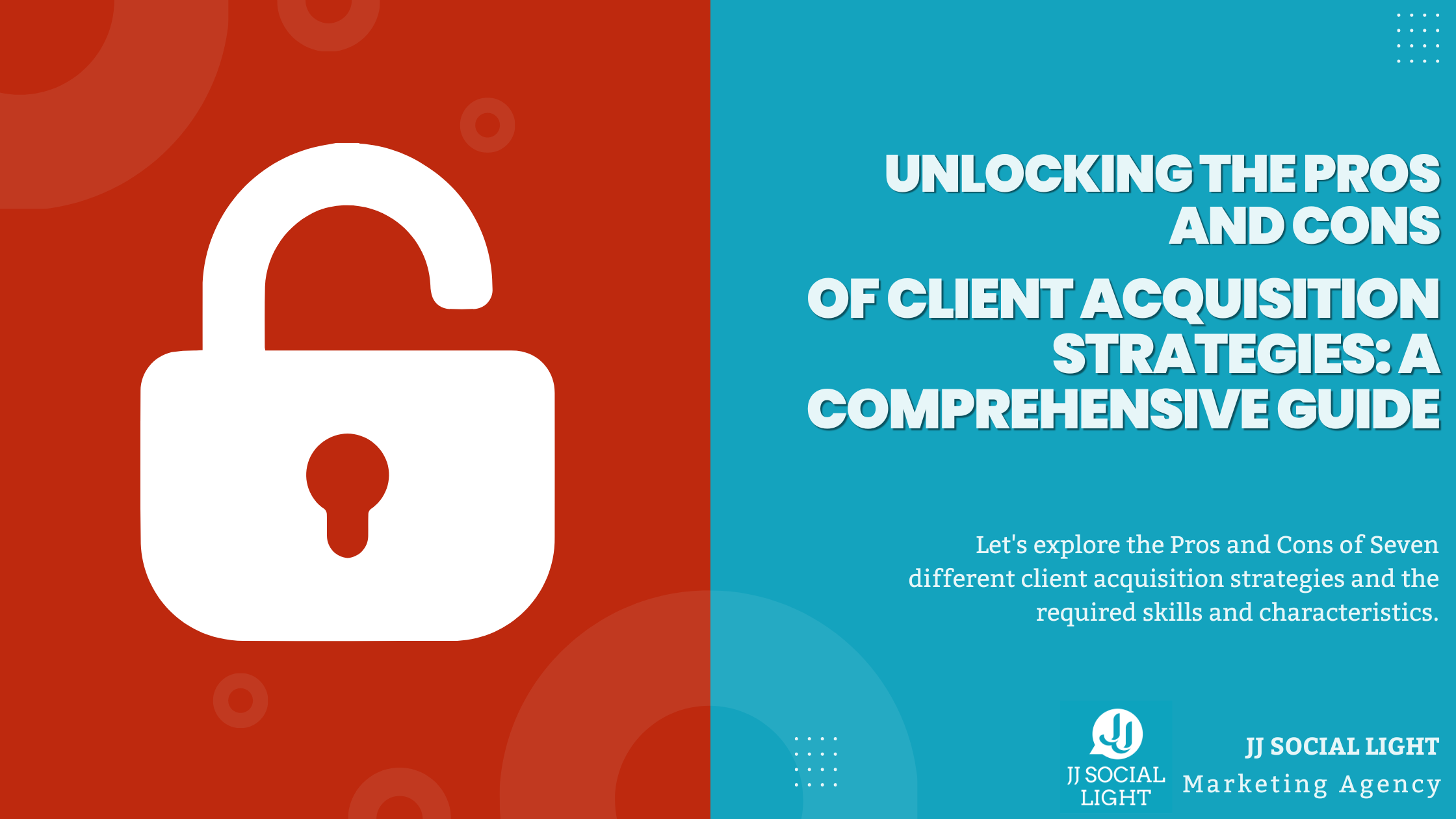As a business owner, it is crucial to have an effective client acquisition strategy in place. However, with so many different strategies, it can take time to determine the most effective for your business. This article will explore the pros and cons of seven different client acquisition strategies and the skills and characteristics required for each.
As a marketing agency owner, I face the same challenges as many other business owners – figuring out the best customer acquisition method. That’s why I often turn to online communities for insights and inspiration. One of my favorite groups is The Admin Bar Community on Facebook. Recently, I came across a fantastic table created by Kyle Van Deusen in Notion, which listed various client acquisition strategies. I found these strategies to apply to a wide range of businesses, so with Kyle’s permission; I’ve expanded upon them to help others understand their options for acquiring new clients.
Skills/Characteristics Required
Before diving into the specific client acquisition strategies, it is important to understand the importance of skills and characteristics in the process. Regardless of the strategy, some several key skills and characteristics are essential for success. These include strong communication skills, building relationships, a deep understanding of your target audience, and tracking and measuring your results.
In addition to these key skills, each client acquisition strategy requires unique skills and characteristics. For example, content marketing requires strong writing and storytelling skills and research and analytical skills. Referral marketing, on the other hand, requires a deep understanding of your network and the ability to build and maintain relationships with key stakeholders.
Without further ado, let’s jump right in and explore these client acquisition strategies in detail!
Tactic 1: Content Marketing
Content marketing is a strategy to attract and engage your target audience by creating and sharing high-quality, relevant, and valuable content. Pros of content marketing include the ability to build authority and trust, attract organic traffic, and cost-effectiveness. However, content marketing can be time-consuming, requiring ongoing effort and optimization to achieve the best results.
Pros of Content Marketing
- Builds authority and trust: By creating high-quality, informative content that addresses the needs and challenges of your target audience, you can establish yourself as an authority in your industry and build trust with potential clients.
- Attracts organic traffic: Content marketing can help you attract organic traffic to your website by ranking high in search engine results pages (SERPs) for specific keywords and phrases. This can help you reach a wider audience and increase your brand awareness.
- Cost-effective long-term: Content marketing can be a cost-effective long-term strategy, as high-quality content can continue attracting traffic and generating leads long after publication.
Cons of Content Marketing
- Time-consuming: Content marketing can be time-consuming, requiring ongoing effort and optimization to achieve the best results. It can take 6-12 months or more to see significant results from your efforts.
- Requires consistent effort: Content marketing is not a set-and-forget strategy. Creating and publishing high-quality content that resonates with your target audience requires constant effort.
- Can take time to see results: Content marketing can take time to see results, as it can take time for your content to rank high in SERPs and attract organic traffic.
Skills/Characteristics Required for Content Marketing
To be successful with content marketing, you need strong writing and storytelling skills, research and analytical skills, knowledge of your target audience and industry, and the ability to generate engaging ideas. You also need to be able to use content marketing tools effectively, such as content management systems, social media platforms, and analytics tools, to track and measure your results.
Some successful examples of content marketing include HubSpot’s inbound marketing strategy, which includes blog posts, eBooks, and webinars, and Red Bull’s content marketing strategy, which includes videos, social media posts, and events.
Content Marketing FAQs
What is content marketing?
Content marketing is a strategy to attract and engage your target audience by creating and sharing high-quality, relevant, and valuable content.
How long does it take to see results from content marketing?
Content marketing can take 6-12 months or more to see significant results from your efforts. However, high-quality content can continue attracting traffic and generating leads long after publication.
What are the most important skills/characteristics for content marketing?
The most important skills/characteristics for content marketing include strong writing and storytelling skills, research and analytical skills, knowledge of your target audience and industry, and the ability to generate engaging ideas. You also need to be able to use content marketing tools effectively to track and measure your results.
Can content marketing be used in combination with other client acquisition strategies?
Yes, content marketing can be combined with other client acquisition strategies, such as SEO or referral marketing.
Tactic 2: Referral Marketing
Referral marketing is a strategy to attract new clients by encouraging your existing clients to refer their friends and colleagues to your business. Referral marketing pros include leveraging your existing network, building trust and credibility, and being cost-effective. However, referral marketing can be unpredictable, requiring ongoing effort to maintain and optimize your referral program.
Pros of Referral Marketing
- Leverages your existing network: Referral marketing allows you to leverage your existing network of clients and contacts to attract new clients. This can help you reach a wider audience and increase your brand awareness.
- Builds trust and credibility: Referral marketing can help build trust and credibility with potential clients, as they are more likely to trust a recommendation from someone they know and trust.
- Cost-effective: Referral marketing can be a cost-effective client acquisition strategy, as you don’t need to pay for clicks or impressions. Instead, you invest in maintaining and optimizing your referral program.
Cons of Referral Marketing
- Unpredictable: Referral marketing can be unpredictable, as you rely on your existing clients to refer new business. This can make forecasting and planning for your client acquisition goals challenging.
- Requires ongoing effort: Referral marketing is not a set-and-forget strategy. Maintaining and optimizing your referral program requires ongoing effort, including providing referral incentives and rewards and tracking your results.
- Can be limited by your existing network: Referral marketing is limited by the size and quality of your existing network. Attracting new clients through referrals can be challenging if you don’t have a large or engaged network.
Skills/Characteristics Required for Referral Marketing
To be successful with referral marketing, you need strong relationship-building skills, the ability to provide exceptional customer service and experiences, and the ability to create and maintain effective referral programs. You also need to be able to track and measure your results to optimize your program over time.
Some successful referral marketing examples include Dropbox’s referral program, which offers incentives for both the referrer and the new user, and Active Campaign’s Ambassador Program, which offers $100 for referrals.
Referral Marketing FAQs
What is referral marketing?
Referral marketing is a strategy to attract new clients by encouraging your existing clients to refer their friends and colleagues to your business.
How do you create an effective referral program?
To create an effective referral program, you need to provide incentives and rewards for referrals, track and measure your results, and provide exceptional customer service and experiences to encourage referrals.
What are the most important skills/characteristics for referral marketing?
The most important skills/characteristics for referral marketing include solid relationship-building skills, the ability to provide exceptional customer service and experiences, and the ability to create and maintain effective referral programs. You also need to be able to track and measure your results to optimize your program over time.
Can referral marketing be used in combination with other client acquisition strategies?
Yes, referral marketing can be combined with other client acquisition strategies, such as PPC advertising or content marketing.
How can I incentivize my existing clients to refer new business to me?
You can incentivize your existing clients to refer new businesses by offering rewards and incentives, such as discounts, exclusive access, or free products or services. It’s important to clearly communicate the benefits of your referral program and make it easy for clients to refer their friends and colleagues.
Tactic 3: Social Media Marketing
Social media marketing is a strategy to attract and engage your target audience through social media platforms such as Facebook, Instagram, Twitter, and LinkedIn. Pros of social media marketing include reaching a large and engaged audience, building brand awareness, and being cost-effective. However, social media marketing can take time, requiring ongoing effort and optimization to achieve the best results.
Pros of Social Media Marketing
- Reaches a large and engaged audience: Social media marketing allows you to reach a large and engaged audience on popular platforms such as Facebook, Instagram, Twitter, and LinkedIn. This can help you increase your brand awareness and attract new clients.
- Builds brand awareness: Social media marketing can help you build brand awareness by creating and sharing high-quality content that resonates with your target audience. This can help you establish your brand as an authority in your industry and build trust with potential clients.
- Cost-effective: Social media marketing can be a cost-effective client acquisition strategy, as you don’t need to pay for clicks or impressions. Instead, you can focus on creating and sharing high-quality content that resonates with your target audience.
Cons of Social Media Marketing
- Time-consuming: Social media marketing can be time-consuming, as it requires ongoing effort to create and share high-quality content, engage with your audience, and track and measure your results.
- Requires ongoing effort: Social media marketing is not a set-and-forget strategy. It requires ongoing effort and optimization to achieve the best results, including analyzing your data and adjusting your strategy as needed.
- Can be limited by platform algorithms: Social media marketing can be limited by platform algorithms, which can affect the visibility and reach of your content. This can make it challenging to achieve your client acquisition goals through social media alone.
Skills/Characteristics Required for Social Media Marketing
To be successful with social media marketing, you need strong writing and storytelling skills, knowledge of your target audience and industry, and the ability to create and share engaging content. You also need to be able to use social media marketing tools effectively, such as social media management platforms and analytics tools, to track and measure your results.
Some successful examples of social media marketing include Wendy’s Twitter account, which engages with its audience in a humorous and irreverent way, and Glossier’s Instagram account, which features user-generated content and promotes its products in a visually appealing way.
Social Media FAQs
What is Social Media Marketing (SMM)?
Social Media Marketing is a strategy to attract and engage your target audience through social media platforms such as Facebook, Instagram, Twitter, and LinkedIn.
How can I create engaging content for Social Media?
To create engaging content for social media, you need to know your target audience and industry, use high-quality images and videos, write compelling captions and headlines, and use social media management tools to schedule and publish your content.
What are the most important skills/characteristics for Social Media Marketing?
The most important skills/characteristics for social media marketing include strong writing and storytelling skills, knowledge of your target audience and industry, and the ability to create and share engaging content. You also need to be able to use social media marketing tools effectively to track and measure your results.
Can Social media Marketing be used in combination with other client acquisition strategies?
Yes, social media marketing can be combined with other client acquisition strategies, such as PPC advertising or content marketing.
How can I measure the success of my Social Media Marketing efforts?
You can measure the success of your social media marketing efforts by tracking metrics such as engagement rate, follower growth, website traffic, and conversion rate. You can use social media analytics tools to gather and analyze this data, and adjust your strategy as needed to improve your results.
Which Social Media platforms should I focus on for my business?
The social media platforms you should focus on for your business depends on your target audience and industry. For example, suppose you are targeting a younger audience. In that case, you may want to focus on platforms like Instagram and TikTok, while if you are targeting a professional audience, you may want to focus on platforms like LinkedIn.
What types of content work best for Social Media Marketing?
The types of content that work best for social media marketing depend on your target audience and industry. Some types of content that tend to perform well include high-quality images and videos, informative and educational posts, user-generated content, and interactive content such as polls and quizzes.
How often should I post on Social Media?
The frequency of your social media posts depends on your target audience and industry. Generally, it’s recommended to post at least once a day on most social media platforms, but you may need to adjust your frequency based on your audience’s engagement and preferences.
How can I use Social Media to generate leads for my business?
You can use social media to generate leads for your business by creating and sharing high-quality content that resonates with your target audience, using social media ads to target specific audiences, and promoting your products or services to encourage engagement and conversions.
Tactic 4: Networking
Networking is a strategy to build relationships and connections with individuals and organizations in your industry or target audience. Pros of networking include building trust and credibility, expanding your professional network, and being cost-effective. However, networking can be time-consuming, requiring ongoing effort and relationship-building to achieve the best results.
Pros of Networking
- Builds trust and credibility: Networking allows you to build trust and credibility with individuals and organizations in your industry or target audience. This can help you establish yourself as an authority in your field and build strong relationships with potential clients.
- Expands your professional network: Networking can help you grow your professional network by connecting you with individuals and organizations that can provide valuable referrals, collaborations, and opportunities.
- Cost-effective: Networking can be a cost-effective client acquisition strategy, as it doesn’t require advertising or marketing expenses. Instead, you invest your time and effort into building relationships and connections.
Cons of Networking
- Time-consuming: Networking can be time-consuming, requiring ongoing effort and relationship-building to achieve the best results. This can make it challenging to balance networking with other business priorities.
- Requires ongoing effort: Networking is not a set-and-forget strategy. It requires ongoing effort to maintain and expand your professional network, including attending events, following up with contacts, and providing value to your network.
- Can be unpredictable: Networking can be unpredictable, as you rely on your professional network to provide referrals, collaborations, and opportunities. This can make forecasting and planning for your client acquisition goals challenging.
Skills/Characteristics Required for Networking
To be successful with networking, you need strong relationship-building skills, the ability to provide value to your network, and the ability to follow up and maintain relationships over time. You also need to be able to identify and attend relevant industry events and use networking tools effectively to manage and expand your professional network.
Some successful examples of networking include attending industry events and conferences, participating in online communities and forums, and joining professional organizations in your industry.
Networking FAQs
What is networking?
Networking is a strategy to build relationships and connections with individuals and organizations in your industry or target audience.
How can I provide value to my professional network?
You can provide value to your professional network by sharing knowledge and expertise, offering assistance and support, and making relevant introductions and connections.
What are the most important skills/characteristics for networking?
The most important skills/characteristics for networking include solid relationship-building skills, the ability to provide value to your network, and the ability to follow up and maintain relationships over time. You also need to be able to identify and attend relevant industry events and use networking tools effectively.
Can networking be used in combination with other client acquisition strategies?
Yes, networking can be combined with other client acquisition strategies, such as PPC advertising or content marketing.
How can I measure the success of my networking efforts?
You can measure the success of your networking efforts by tracking metrics such as the number of new connections, the quality of those connections, and the number of referrals and collaborations generated from your network. You can use networking tools and CRM software to track and manage your network and analyze your results.
Tactic 5: Email Marketing
Email marketing is a strategy to promote your products or services through email campaigns targeted at your subscriber list. Pros of email marketing include the ability to reach a highly engaged audience, personalizing your messages, and tracking and measuring your results. However, email marketing can be challenging to get right, requiring ongoing effort and optimization to achieve the best results.
Pros of Email Marketing
- Reaches a highly engaged audience: Email marketing allows you to reach a highly engaged audience of individuals who have opted in to receive your emails. This can increase your open and click-through rates and generate more leads and sales.
- Personalizes your messages: Email marketing allows you to personalize your messages based on your subscribers’ interests, behavior, and preferences. This can help you increase the relevance and effectiveness of your campaigns and build stronger relationships with your subscribers.
- Track and measure your results: Email marketing allows you to track and measure your results, including open rates, click-through rates, conversion rates, and revenue generated from your campaigns. This can help you optimize your campaigns and improve your client acquisition results over time.
Cons of Email Marketing
- Challenging to get right: Email marketing can be challenging, as it requires a deep understanding of your subscribers’ interests and preferences and strong copywriting and design skills.
- Requires ongoing effort: Email marketing is not a set-and-forget strategy. It requires ongoing effort to create and send high-quality campaigns, segment and personalize your messages and track and measure your results.
- Can be limited by email deliverability: Email marketing can be limited by email deliverability, which can affect the visibility and reach of your campaigns. This can make it challenging to achieve your client acquisition goals through email marketing alone.
Skills/Characteristics Required for Email Marketing
To be successful with email marketing, you need strong copywriting and design skills, knowledge of your subscribers’ interests and preferences, and the ability to segment and personalize your messages effectively. You also need to be able to use email marketing tools effectively, such as email marketing software and analytics tools, to track and measure your results.
Some successful examples of email marketing include personalized welcome campaigns, targeted promotional campaigns, and behavior-triggered campaigns that respond to subscriber actions or inactions.
Email Marketing FAQs
What is email marketing?
Email marketing is a strategy to promote your products or services through email campaigns targeted at your subscriber list.
How can I personalize my email campaigns?
You can personalize your email campaigns by segmenting your subscriber list based on demographics, behavior, and interests and by using dynamic content, personalization tokens, and targeted messaging to tailor your messages to each subscriber.
What are the most important skills/characteristics for email marketing?
The most important skills/characteristics for email marketing include strong copywriting and design skills, knowledge of your subscribers’ interests and preferences, and the ability to segment and personalize your messages effectively. You also need to be able to use email marketing tools effectively to track and measure your results.
Can email marketing be used in combination with other client acquisition strategies?
Yes, email marketing can be combined with other client acquisition strategies, such as PPC advertising or content marketing.
How can I measure the success of my email marketing campaigns?
You can measure the success of your email marketing campaigns by tracking metrics such as open rates, click-through rates, conversion rates, and revenue generated from your campaigns. You can use email marketing software and analytics tools to track and analyze this data and adjust your strategy as needed to improve your results. You can also conduct A/B testing to compare the effectiveness of different elements of your campaigns, such as subject lines, messaging, and design.
How often should I send emails to my subscribers?
The frequency of your email campaigns depends on your target audience and industry. Generally, sending at least one email per week is recommended, but you may need to adjust your frequency based on your subscribers’ engagement and preferences.
How can I grow my email subscriber list?
You can grow your email subscriber list by offering valuable incentives, such as exclusive content or discounts, in exchange for email sign-ups. You can also promote your email campaigns through social media, paid advertising, and other marketing channels and optimize your website and landing pages to encourage email sign-ups.
How can I avoid my emails being marked as spam?
To avoid your emails being marked as spam, you should ensure that your emails are relevant and valuable to your subscribers, use a recognizable sender name and email address, and include an unsubscribe link in your emails. You should also follow best practices for email marketing, such as avoiding spam trigger words and regularly clean your email list to remove inactive or invalid subscribers.
How can I use email marketing to generate leads for my business?
You can use email marketing to generate leads for your business by creating and sharing high-quality content that resonates with your target audience, promoting your products or services to encourage engagement and conversions, and using targeted campaigns to promote lead magnets or other incentives for email sign-ups. You can also use email marketing to nurture leads over time and move them through your sales funnel.
Tactic 6: Pay-Per-Click Advertising (PPC)
Pay-per-click (PPC) advertising is a form of digital marketing that allows businesses to place ads on search engines, social media platforms, and other websites and pay only when a user clicks on the ad. Pros of PPC advertising include the ability to control your ad spend, precise targeting, and immediate results. However, PPC advertising can be expensive and requires ongoing optimization to achieve the best results.
Pros of PPC Advertising
- Control over ad spend: With PPC advertising, you can set a daily or monthly budget for your campaigns and only pay when a user clicks on your ad. This allows you to control your ad spend and avoid overspending.
- Precise targeting: PPC advertising allows you to target your ads to specific demographics, interests, and behaviors, ensuring that the right people see your ads.
- Immediate results: Unlike other client acquisition strategies, PPC advertising can provide quick results. You can start seeing traffic to your website and conversions within a few hours of launching your campaign.
Cons of PPC Advertising
- Cost: PPC advertising can be expensive, especially if you are competing in a crowded market. You need to be careful to manage your ad spend effectively to avoid overspending.
- Ongoing optimization required: PPC advertising requires ongoing optimization to achieve the best results. You must continually monitor your campaigns and adjust your targeting, ad copy, and landing pages to improve your results.
- Click fraud: Click fraud is a significant concern with PPC advertising. Click fraud occurs when a competitor or other malicious actor clicks on your ads repeatedly, driving up your costs and reducing the effectiveness of your campaigns.
Skills/Characteristics Required for PPC Advertising
To succeed in PPC advertising, you need to have a thorough knowledge of your target audience, excellent copywriting skills, and proficiency in measuring and analyzing your campaign performance. Effective utilization of analytics tools is also crucial to optimize your campaigns regularly.
One prominent example of successful PPC advertising is the display of sponsored product ads at the top of Google search results. These ads have significantly helped businesses increase their sales and revenue.
PPC FAQs
What is Pay-Per-Click advertising?
Pay-per-click advertising is a form of digital advertising that allows businesses to place ads on search engines, social media platforms, and other websites and pay only when a user clicks on the ad.
How much does PPC advertising cost?
The cost of PPC advertising can vary depending on the platform, targeting, and competition. Setting a budget and managing your ad spend effectively is essential to avoid overspending.
What are the most important skills/characteristics for PPC advertising?
The most important skills/characteristics for PPC advertising include a deep understanding of your target audience, strong copywriting skills, the ability to track and measure your results, and the willingness to optimize your campaigns continually.
Can PPC advertising be used in combination with other client acquisition strategies?
Yes, PPC advertising can be combined with other client acquisition strategies, such as content marketing or referral marketing.
How can I optimize my PPC campaigns for better results?
You can continually monitor and adjust your targeting, ad copy, and landing pages based on the data to optimize your PPC campaigns for better results. It’s essential to use analytics tools to track your ad spend, clicks, and conversions and make data-driven decisions about improving your campaigns.
What is click fraud, and how can I prevent it?
Click fraud is when a competitor or other malicious actor clicks on your ads repeatedly, driving up your costs and reducing the effectiveness of your campaigns. To prevent click fraud, you can use tools like Google Ads’ Click Fraud Protection or hire a third-party service to monitor your campaigns for fraudulent clicks.
What are some common mistakes to avoid in PPC advertising?
Some common mistakes to avoid in PPC advertising include failing to target the right audience, using irrelevant or poorly written ad copy, overspending on ad spend, and failing to optimize your campaigns based on the data.
Tactic 7: Search Engine Optimization (SEO)
Search engine optimization (SEO) is a strategy to improve your website’s visibility and ranking in search engine results pages (SERPs) for specific keywords and phrases. Pros of SEO include attracting organic traffic, establishing authority and trust, and cost-effectiveness. However, SEO can be time-consuming, requiring ongoing effort and optimization to achieve the best results.
Pros of SEO
- Attracts organic traffic: SEO helps you attract organic traffic to your website by ranking high in SERPs for specific keywords and phrases. This can help you reach a wider audience and increase your brand awareness.
- Establishes authority and trust: SEO can help establish your authority and trust in your industry by ranking high in SERPs. This can help you build credibility with potential clients and increase conversions.
- Cost-effective: SEO can be a cost-effective client acquisition strategy, as you don’t need to pay for clicks or impressions. Instead, you invest in optimizing your website to attract organic traffic.
Cons of SEO
- Time-consuming: SEO can be time-consuming, requiring ongoing optimization and effort to achieve the best results. It can take 6-12 months or more to see significant results from your efforts.
- Requires ongoing optimization: SEO is not a set-and-forget strategy. It requires ongoing optimization to keep up with changes in search algorithms and stay ahead of your competitors.
- Results can be unpredictable: SEO results can be unpredictable, as search algorithms are constantly changing. Even with the best optimization efforts, there is no guarantee that your website will rank high in SERPs for your target keywords.
Skills/Characteristics Required for SEO
To be successful with SEO, you need strong writing and storytelling skills, research and analytical skills, knowledge of your target audience and industry, and the ability to generate engaging ideas. You also need to be able to use SEO tools effectively, such as Google Analytics and Google Search Console, to track and measure your results.
Some successful examples of SEO include Moz’s Beginner’s Guide to SEO, which has helped the company establish authority in the industry and attract organic traffic to its website, and HubSpot’s inbound marketing strategy, which includes SEO optimization and has helped the company grow their business and revenue.
SEO FAQs
What is Search Engine Optimization (SEO)?
Search engine optimization (SEO) is a strategy to improve your website’s visibility and ranking in search engine results pages (SERPs) for specific keywords and phrases.
How long does it take to see results from SEO?
SEO can take 6-12 months or more to see significant results from your efforts. However, it’s essential to continually optimize your website and content to stay ahead of your competitors and achieve the best results.
What are the most important skills/characteristics for SEO?
SEO’s most important skills/characteristics include strong writing and storytelling skills, research and analytical skills, knowledge of your target audience and industry, and the ability to generate engaging ideas. You also need to be able to use SEO tools effectively to track and measure your results.
Can SEO be used in combination with other client acquisition strategies?
Yes, SEO can be combined with other client acquisition strategies, such as content marketing or PPC advertising.
How can I optimize my website for SEO?
To optimize your website for SEO, you can focus on creating high-quality, engaging content that includes your target keywords and phrases. You can also optimize your website’s technical structure, such as improving page speed, using header tags appropriately, and optimizing your images. It’s also essential to build high-quality backlinks to your website from reputable sources.
What is the difference between on-page and off-page SEO?
On-page SEO refers to optimizing the content and structure of your website to improve your ranking in search engine results pages. This includes optimizing your content, images, and technical structure. Off-page SEO refers to building high-quality backlinks to your website from other reputable sources, which can help improve your ranking in search results.
What are some common mistakes to avoid in SEO?
Some common mistakes to avoid in SEO include using irrelevant or spammy keywords, creating low-quality or duplicate content, neglecting technical SEO aspects, and building low-quality backlinks. It’s essential to focus on creating high-quality content and optimizing your website for both users and search engines.
Final thoughts
Effective client acquisition strategies are critical for the success of any business. By understanding the pros and cons of different strategies and the skills and characteristics required for each, you can choose the right approach for your specific business and achieve your goals. Remember to continually test and optimize your efforts and be willing to adapt your strategy based on the data.
Wrapping up: FAQs Answered about Client Acquisition Strategies
What is the best client acquisition strategy?
The best client acquisition strategy depends on your specific business and target audience. It is essential to continually test and measure your efforts and adapt your approach based on the data.
How long does it take to see results from client acquisition strategies?
The time to see results can vary depending on the strategy and your business. Some strategies, such as paid advertising, can provide immediate results, while others, such as content marketing, can take 6-12 months or more to see significant results.
What are the most important skills/characteristics for client acquisition?
The most important skills/characteristics for client acquisition include strong communication skills, the ability to build relationships, a deep understanding of your target audience, and the ability to track and measure your results. Specific strategies may require additional skills, such as strong writing and storytelling skills for content marketing or strong persuasion skills for cold calling.
Can multiple client acquisition strategies be used simultaneously?
Yes, multiple client acquisition strategies can be used simultaneously. However, it is essential to prioritize and focus on the most effective strategy for your specific business and target audience.
What are some common mistakes to avoid in client acquisition strategies?
Some common mistakes to avoid in client acquisition strategies include failing to understand your target audience, using a one-size-fits-all approach, being too sales-focused, and failing to track and measure your results.
If you’re looking for expert guidance in implementing any client acquisition strategies outlined in this article, don’t hesitate to contact JJ Social Light. Our team of experienced marketing professionals can help you develop and execute a custom strategy that drives results for your business. Contact us today to schedule a consultation!








0 Comments